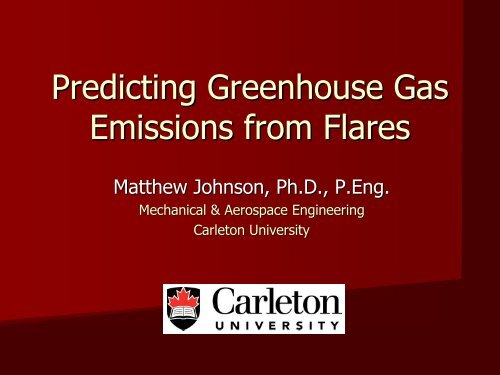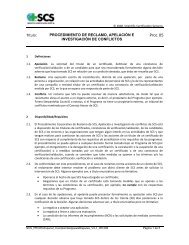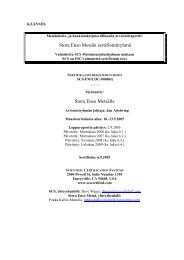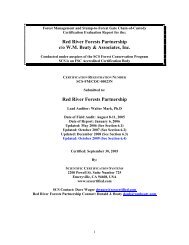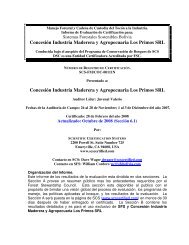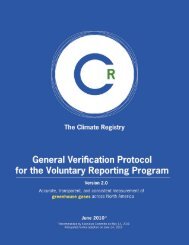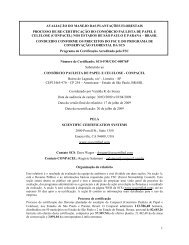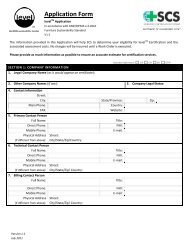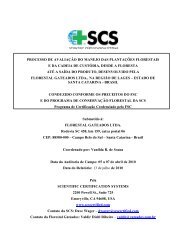Predicting Greenhouse Gas Emissions From Flares - SCS Global ...
Predicting Greenhouse Gas Emissions From Flares - SCS Global ...
Predicting Greenhouse Gas Emissions From Flares - SCS Global ...
Create successful ePaper yourself
Turn your PDF publications into a flip-book with our unique Google optimized e-Paper software.
<strong>Predicting</strong> <strong>Greenhouse</strong> <strong>Gas</strong><br />
<strong>Emissions</strong> from <strong>Flares</strong><br />
Matthew Johnson, Ph.D., P.Eng.<br />
Mechanical & Aerospace Engineering<br />
Carleton University
Flaring in Alberta<br />
• Although there have been significant reductions<br />
in previous years, in 2003, 1.4 billion m 3 of gas<br />
were flared or vented in Alberta<br />
(843 million m 3 of solution gas)<br />
(AEUB, ST60B, 2004)
<strong>Greenhouse</strong> <strong>Gas</strong> <strong>Emissions</strong><br />
• Worldwide an estimated 76 billion m 3 of gas<br />
were flared or vented in 2002<br />
• Significant source of CO 2<br />
equivalent emissions
Project Objective<br />
• Develop a research backed protocol for<br />
estimating greenhouse gas (CO 2 equivalent<br />
emissions) from solution gas flares<br />
– Extend results of previous windtunnel based research<br />
with large parametric data set<br />
– Continue to evolve and improve parametric efficiency<br />
model<br />
• Project is possible because data base of fully-<br />
controlled, parametric experiments exists!
Previous Work<br />
• Research focussed on carbon conversion<br />
efficiency<br />
Mass of Carbon Converted to CO2<br />
η =<br />
Mass of Carbon Originally as Fuel<br />
• Significant progress in quantifying efficiencies of<br />
non-sooting flares under a range of conditions<br />
– Crosswind, Diameter, Exit Velocity, Basic fuel<br />
composition (sweet), Diluent content
Previous Work<br />
• Fuel stripping mechanism identified responsible<br />
for emissions of raw flare gas<br />
• Semi-empirical empirical flare efficiency model developed<br />
(Johnson & Kostiuk, P. Comb. Inst. 2002) and<br />
verified at full scale<br />
⎡<br />
3<br />
LHV mass<br />
= A⋅<br />
exp⎢B<br />
⎢⎣<br />
( ) ( )<br />
1 −η<br />
⋅<br />
∞<br />
⎤<br />
( d )<br />
1/ 3<br />
⎥ ⎥ j o ⎦<br />
gV<br />
U
Efficiency<br />
Model<br />
• Correlation<br />
effectively collapses<br />
widely varied data<br />
(1-η)(LHV mass ) 3 (MJ/kg) 3<br />
• Data includes<br />
n.g. + CO 2<br />
n.g. + N 2<br />
C 3 H 8 + CO 2<br />
C 3 H 8 + N 2<br />
C 2 H 6 + N 2<br />
2 ≤ U ∞ ≤ 17 m/s<br />
0.5 ≤ V j ≤ 4 m/s<br />
12.2 ≤ d o ≤ 49 mm<br />
25000<br />
20000<br />
15000<br />
10000<br />
5000<br />
0<br />
Natural gas based fuel<br />
Propane based fuel<br />
Ethane based fuel<br />
(0.317 X)<br />
Y = 156.4 e<br />
(0.272 X)<br />
Y = 32.06 e<br />
LHVmassCorr-Qorf-2-UgVD13.GRF<br />
0 5 10 15 20 25<br />
U ∞ / (g V j d o ) 1/3
<strong>Greenhouse</strong> <strong>Gas</strong>es (GHG)<br />
• Kyoto Accord specifically names six gases /<br />
types of gases that contribute to global warming<br />
– carbon dioxide (CO 2 );<br />
– methane (CH 4 );<br />
– nitrous oxide (N 2 O);<br />
– hydrofluorocarbons (HFCs);<br />
– perfluorocarbons (PFCs); and<br />
– sulphur hexafluoride (SF 6 ).<br />
• Climate forcing also occurs from other<br />
substances not yet named in the Kyoto Accord
GHGs Relevant for Flare <strong>Emissions</strong><br />
• Principle contributors are carbon dioxide and<br />
methane<br />
• Other species may be relevant based on IPCC<br />
data but do not have accepted GWP values and<br />
are not included in Kyoto Accord:<br />
– CO and particulate matter (Direct climate forcing)<br />
– NOx and SO 2 (Indirect climate forcing)<br />
• In line with Kyoto, consider CO 2 and CH 4 only
<strong>Global</strong> Warming Potentials (GWPs(<br />
GWPs)<br />
• Relative measure of climate forcing of 1kg of<br />
substance compared to 1kg of CO 2<br />
– Usually defined on a 100 year time horizon<br />
– Established by Intergovernmental Panel on Climate<br />
Change (IPCC)<br />
– Used to make GHG calculations on a CO 2 equivalent<br />
basis<br />
<strong>Gas</strong><br />
Lifetime<br />
(years)<br />
<strong>Global</strong> Warming Potential<br />
(Time horizon in years)<br />
20 yrs 100 yrs 500 yrs<br />
Carbon dioxide CO 2<br />
1 1 1<br />
Methane CH 4<br />
12.0 62 23 7
GHG Calculation Methodology<br />
• First calculate instantaneous rate of CO 2 and<br />
CH 4 emissions<br />
– Must accurately determine split, γ, , between CO and<br />
unburned fuel in emissions<br />
– Existing efficiency model does not provide this<br />
information<br />
– Major part of ongoing work is to develop better<br />
model for this split, γ<br />
– However, data suggest CO is much less important<br />
and γ =0.1 is a reasonable estimate for now
GHG Calculation Methodology<br />
• Calculation of instantaneous GHG emission<br />
1. Given fuel composition and operational parameters<br />
(flare diameter, exit velocity, wind speed), use<br />
parametric model to calculate efficiency (η)(<br />
2. Use fuel composition and modeled CO/fuel split<br />
parameter (γ)(<br />
) to find mass emission rate of CH 4 and<br />
CO<br />
3. Use IPCC global warming potential values to<br />
calculate instantaneous GHG emission<br />
m& equiv<br />
= GWP ⋅m&<br />
+ m&<br />
GHG<br />
CH<br />
4 CH4<br />
CO2
GHG Calculation Methodology<br />
• Must convert instantaneous GHG emission<br />
calculated at one wind speed value to<br />
meaningful “average” value<br />
• Concept of “Yearly Averaged Efficiency” and<br />
“Yearly Averaged GHG Equivalent Emission”<br />
– Possible to develop using parametric data set and<br />
efficiency model
Yearly Averaged Efficiency<br />
• Statistical weighted average of efficiency taking<br />
into account widely varying wind conditions<br />
• Provides convenient and meaningful measure of<br />
flare efficiency<br />
where<br />
η =<br />
∞<br />
∫<br />
0<br />
P( U ) η(<br />
U ) dU<br />
∞<br />
P(U ∞ ) = probability distribution<br />
function of wind speed<br />
U ∞ = wind speed<br />
η(U ∞ ) = efficiency of flare as<br />
function of wind speed<br />
∞<br />
∞
Yearly Averaged Efficiency<br />
Relative Frequency<br />
0.30<br />
0.25<br />
0.20<br />
0.15<br />
0.10<br />
0.05<br />
Environment Canada<br />
Hourly Averaged Wind Speed Data<br />
for Edmonton International Airport<br />
(1984-1988)<br />
(1-η)(LHV mass ) 3 (MJ/kg) 3<br />
25000<br />
20000<br />
15000<br />
10000<br />
5000<br />
12.1 mm ≤ do ≤ 49.8 mm<br />
Natural <strong>Gas</strong> + CO 2 or N 2<br />
Y = 146.5 e (0.1745 X)<br />
0.00<br />
E:\IR-YEG84-88HAVG.GRF<br />
0<br />
LHVmassCorr-NG-Qorf-2-Dia-UgV13D12.GRF<br />
0 2 4 6 8 10 12 14 16 18 20<br />
Hourly Averaged Wind Speed (m/s)<br />
0 5 10 15 20 25 30 35<br />
U ∞ / [(gV j ) 1/3 (d o 1/2 )] (m -1/6 )
Sample GHG Prediction<br />
Calculations
Scenario #1: Mean Solution <strong>Gas</strong> Flare<br />
• Operating Parameters:<br />
– Q = 246,900 m 3 /yr<br />
– D = 4 inch<br />
– Flare <strong>Gas</strong> = 95 % Methane, 5 % CO 2<br />
– LHV = 32.2 MJ/m 3<br />
– Flare location: Edmonton (Airport weather data)<br />
• Yearly Averaged Efficiency: 99.4 %<br />
• Annual CO 2 equivalent GHG emission: 477 tonnes
Scenario #2: “Low BTU” Solution<br />
• Operating Parameters:<br />
<strong>Gas</strong> Flare<br />
– Q = 246,900 m 3 /yr<br />
– D = 4 inch<br />
– <strong>Gas</strong> = 50 % Methane, 50 % CO 2<br />
– LHV = 16.9 MJ/m 3<br />
– Flare location: Edmonton (Airport weather data)<br />
• Yearly Averaged Efficiency: 78.9 %<br />
• Annual CO 2 equivalent GHG emission: 778 tonnes
Scenario #3: Variable Composition<br />
• Mean Volume<br />
Solution <strong>Gas</strong><br />
Flare<br />
Q = 246,900 m 3 /yr<br />
D = 4 inch<br />
<strong>Gas</strong> = CH 4 / CO 2<br />
Edmonton Airport<br />
weather data<br />
Yearly Averaged Efficiency (%)<br />
100<br />
90<br />
80<br />
70<br />
60<br />
50<br />
246,900 m 3 /yr<br />
4" Diameter Flare<br />
YEG Wind Data<br />
1200<br />
1000<br />
800<br />
600<br />
CO 2 Equivalent GHG <strong>Emissions</strong> (tonnes)<br />
40<br />
FlareGHGCalc-FuelComp.grf<br />
400<br />
0.4 0.5 0.6 0.7 0.8 0.9 1<br />
CH 4 Fraction in Fuel
Scenario #4: Adding CH 4 to<br />
Mitigate GHG<br />
• Mean Volume<br />
Solution <strong>Gas</strong><br />
Flare<br />
Trends vs.<br />
added CH 4<br />
Starting Point:<br />
Q = 246,900 m 3 /yr<br />
D = 4 inch<br />
LHV = 13.55 MJ/m 3<br />
<strong>Gas</strong> = 0.4 CH 4<br />
, 0.6 CO 2<br />
Yearly Averaged Efficiency (%)<br />
100<br />
90<br />
80<br />
70<br />
60<br />
50<br />
40<br />
Adding CH4 to<br />
raw flare gas<br />
4" Diameter Flare<br />
YEG Wind Data<br />
FlareGHGCalc-AddFuel.grf<br />
0 50000 100000 150000 200000 250000<br />
Added CH 4 (m 3 /year)<br />
1150<br />
1100<br />
1050<br />
1000<br />
950<br />
900<br />
850<br />
CO 2 Equivalent GHG <strong>Emissions</strong> (tonnes)
Scenario #4: Adding CH 4 to<br />
Mitigate GHG<br />
• Mean Volume<br />
Solution <strong>Gas</strong><br />
Flare<br />
Trends vs.<br />
Heating Value of<br />
Flare <strong>Gas</strong><br />
Starting Point:<br />
Q = 246,900 m 3 /yr<br />
D = 4 inch<br />
LHV = 13.55 MJ/m 3<br />
<strong>Gas</strong> = 0.4 CH 4<br />
, 0.6 CO 2<br />
Yearly Averaged Efficiency (%)<br />
100<br />
90<br />
80<br />
70<br />
60<br />
50<br />
40<br />
Adding CH 4 to<br />
raw flare gas<br />
4" Diameter Flare<br />
YEG Wind Data<br />
FlareGHGCalc-AddFuel-LHV.grf<br />
12 16 20 24<br />
Lower Heating Value of Flare <strong>Gas</strong> (MJ/m 3 )<br />
1150<br />
1100<br />
1050<br />
1000<br />
950<br />
900<br />
850<br />
CO 2 Equivalent GHG <strong>Emissions</strong> (tonnes)
Conclusions<br />
• It is now possible to define and estimate a<br />
yearly averaged efficiency for a solution gas<br />
flare<br />
– Combines statistical wind speed data with parametric<br />
efficiency model<br />
– Provides a meaningful and rigorous way of assessing<br />
flare performance<br />
– Demonstrates utility of controlled parametric<br />
experiments and modelling
Conclusions<br />
• Outlined preliminary approach to calculate yearly<br />
averaged greenhouse gas equivalent emissions<br />
– Requires more work to accurately segregate CO / CH 4<br />
before being ready for widespread use<br />
– Very useful method for predicting CO 2 equivalent<br />
emissions<br />
– Will permit engineering calculation of “what-if”<br />
scenarios for GHG management and mitigation
Funding Partners


